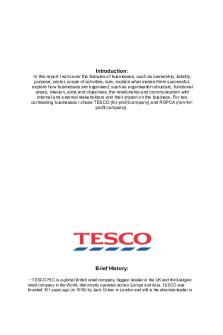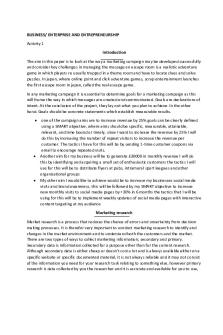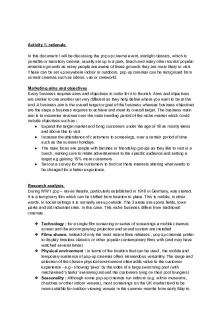BTEC Business Unit 3 Knowledge Organiser PDF

| Title | BTEC Business Unit 3 Knowledge Organiser |
|---|---|
| Author | Ebony Worker |
| Course | Business Placement |
| Institution | Bath Spa University |
| Pages | 14 |
| File Size | 1.5 MB |
| File Type | |
| Total Downloads | 54 |
| Total Views | 184 |
Summary
Finance knowledge organizer, for the use of students....
Description
BTEC National level 3 in Business
UNIT 3 personal and business finance Knowledge Organiser Contains: • Revision checklist • Key terms and definitions • Formula sheet
Student Name:
Revision Checklist Personal Finance Topic
A1 Functions and role of money Functions of money: Unit of account Means of exchange Store of value Legal tender Role of money is affected and influence by a number of factors: Personal attitudes towards risk, reward, borrowing, spending & saving Life stages (childhood, adolescence, young adult, middle age, old age), key features of each stage, financial needs and implications at each stage Culture, including religious and ethical beliefs Life events can vary the personal life cycle from individual to individual External influences/trends and the financial-related effects Interest rate, cost of borrowing versus reward of saving Planning expenditure, common principles to be considered in planning personal finances: To avoid getting into debt To control costs Avoid legal action and/or repossession Remain solvent Maintain a good credit rating Avoid bankruptcy To manage money to fund purchases Generate income and savings Set financial targets and goals Provide insurance against loss or illness Counter the effects of inflation
A2 Different ways to pay The use of money as a payment method, advantages and disadvantages of: Cash Debit card Credit card Cheque Electronic transfer Direct debit Standing order Pre-paid cards Contactless cards Charge cards Store cards Mobile banking Banker’s Automated Clearing Services (BACS) Faster Payment Service (FPS) Clearing House Automated Payment System (CHAPS)
2 BTEC National Level 3 in Business Unit 3 Personal and Business Finance Knowledge Organiser
Notes/ covered
Happy/ done
Topic
Notes/ covered
Happy/ done
A3 Current Accounts Different types, features, advantages and disadvantages, different services offered: Standard Packaged, premium Basic Student
A4 Managing Personal Finance Suitability of different financial products and services against individual needs. Different types, features, advantages and disadvantages, different services offered: Overdraft Personal loans Hire purchase Mortgages Credit cards Payday loans Different types of saving and investment features, advantages and disadvantages: Individual savings accounts (ISAs) Deposit and savings accounts Premium bonds Bonds and gilts Shares Pensions Risks and rewards of savings versus investment Different types of insurance products, features, advantages and disadvantages: Car Home and contents Life assurance and insurance Travel Pet Health
B Explore the personal finance sector B1 Features of financial institutions Types of organisations and their advantages and disadvantages: Bank of England Banks Building societies Credit unions National savings and investments Insurance companies Pension companies Pawnbrokers Payday loans BTEC National Level 3 in Business Unit 3 Personal and Business Finance Knowledge Organiser 3
Topic
Notes/ covered
B2 Communicating with customers Methods of interacting with customers, advantages and disadvantages: Branch Online banking Telephone banking Mobile banking Postal banking
B3 Consumer protection in relation to personal finance Function, role and responsibilities of: Financial Conduct Authority (FCA) Financial Ombudsmen Service (FOS) Financial Services Compensation Scheme (FSCS) Office of Fair Trading (OFT) Legislation – consumer credit
B4 Information guidance and advice Function, role and responsibilities, advantages and disadvantages of: Citizens Advice Independent financial advisor (IFA) Price comparison websites Money advice service Debt counsellors Individual Voluntary Arrangements (IVAs) Bankruptcy
Revision Checklist Business Finance C Understanding the purpose of accounting C1 Purpose of accounting Recording transactions Management of business (planning, monitoring and controlling) Compliance (preventing fraud, compliance with law and regulations) Measuring performance Control - assisting with the prevention of fraud, trade receivables and trade payables
C2 Types of income Capital income: Loan Mortgages Shares Owner’s capital Debentures 4 BTEC National Level 3 in Business Unit 3 Personal and Business Finance Knowledge Organiser
Happy/ done
Topic
Notes/ covered
Happy/ done
Revenue income: Cash sales Credit sales Rent received Commission received Interest received Discount received
C3 Types of expenditure Capital expenditure: Non-current assets – tangible (land, buildings and premises, machineryand equipment, vehicles, fixtures and fittings) Intangible (goodwill, patents, trademarks, brand names) Revenue expenditure: Inventory Rent Rates Heating and lighting Water Insurance Administration Telephone Postage Stationery Salaries Wages Marketing Bank charges Interest paid Straight-line depreciation Reducing balance depreciation Discount allowed
D Select and evaluate different sources of finance D1 Sources of finance Advantages, disadvantages, short-term and long-term: Internal Retained profit Net current assets Sale of assets External Owner’s capital Loans Crowdfunding Mortgages Venture capital Debt factoring Hire purchase
BTEC National Level 3 in Business Unit 3 Personal and Business Finance Knowledge Organiser 5
Topic Leasing Trade credit Grants Donations Peer-to-peer lending Invoice discounting
E Break-even and cash flow forecasts E1 Cash flow forecasts Inflows/receipts Cash sales Credit sales Loans Capital introduced Sale of assets Bank interest received Outflows/payments Cash purchases Credit purchases Rent Rates Salaries Wages Utilities Purchase of assets Value Added Tax (VAT) Bank interest paid Prepare, complete, analyse, revise and evaluate cash flow Use of cash flow forecasts for planning, monitoring, control, target setting Benefits and limitations of cash flow forecasts E2 Break-even analysis Costs Variable Semi-variable Fixed Total Sales Total revenue Total sales Selling price per unit Sales in value and/or units Calculating using/manipulating break-even formula (units and/or sales value), completion of break-even chart, break-even point Identification of area of profit, area of loss Identify and calculate margin of safety (units and value) Calculation of total contribution, contribution per unit benefits and limitations Use of break-even for planning, monitoring, control, target setting Prepare, complete, analyse, revise and evaluate break-even 6 BTEC National Level 3 in Business Unit 3 Personal and Business Finance Knowledge Organiser
Notes/ covered
Happy/ done
Topic
Notes/ covered
Happy/ done
F Complete statements of comprehensive income and financial position and evaluate business performance (Sole Traders) F1 Statement of comprehensive income Purpose and use Completion, calculation and amendment to include gross profit (revenue, opening inventories, purchases, closing inventories, cost of goods sold),calculation of profit/loss for the year (expenses, other income) Adjustments for depreciation (straight-line and reducing balance method) Adjustments for prepayments, accruals Interpretation, analysis and evaluation of statements
F2 Statement of financial position Purpose and use Completion, calculation and amendment of statement using vertical presentation to include: Non-current assets (tangible and intangible, cost, depreciation and amortisation, net book value) Current assets (inventories, trade receivables, prepayments, bank, cash) Current liabilities (bank overdraft, accruals, trade payables) Net current assets/liabilities Non-current liabilities (bank loan and mortgage) Net assets Capital (opening capital, transfer of profit or loss, drawings, closing capital) Adjustments for straight line (cost x%), depreciation, reducing balance (cost – depreciation to date x%) Adjustments for prepayments and accruals Interpretation, analysis and evaluation of statements
F3 Measuring profitability Calculation, interpretation and analysis of: Gross profit margin: (gross profit/revenue) x 100 Mark-up: (gross profit/cost of sales) x 100 Profit margin: (profit/revenue) x 100 Return on capital employed (ROCE): (profit/capital employed) x 100
F4 Measuring liquidity Calculation, interpretation and analysis of: Current ratio: current assets/current liabilities Liquid capital ratio: (current assets – inventory)/current liabilities
F5 Measuring efficiency Calculation, interpretation and analysis of:z Trade receivable days: (trade receivable/credit sales) x 365 Trade payable days: (trade payables/credit purchases) x 365 Inventory turnover: (average inventory/cost of sales) x 365
F6 Limitations of ratios Limitations of ratios when assessing business performance
BTEC National Level 3 in Business Unit 3 Personal and Business Finance Knowledge Organiser 7
Key terms Personal Finance Key Term
Definition
Methods of Payment Cash Debit card Credit card Cheque Electronic transfer Direct debit Standing order Pre-paid card Contactless card Charge card Store card Mobile banking Bankers Automated Clearing Service (BACS) Faster Payment Clearing House Automated Payment Systems (CHAPS)
Notes and coins in a wide range of denominations. Issued by banks with payments for goods and services being deducted directly from a current account. Issued by financial institutions allowing customers to delay payments for goods and services. A written order to a bank to make a specific payment for a specific amount of money from one person’s account to another account. Payment is transferred directly from one bank account to another. An agreement made with a bank allowing a third party to withdraw money from an account on a set day to pay for goods or services received e.g. electricity bill. An agreement made with a bank to transfer a fixed sum of money to a third-party account on a set date on a regular basis e.g. a fixed loan repayment. Money is uploaded onto a card with transactions then withdrawn to reduce the balance. Cards with an embedded chip and antenna that enable consumers to wave their card over a reader at the point of sale for an automatic transaction. Issued by financial institutions allowing customers to delay payments for goods and services for a short period of time with the balance being paid off in full at each statement date. Issued by a retail outlet to allow customers to delay payments for goods and services – similar to a credit card but only for the store(s) specified. The ability to carry out financial transactions using mobile devices such as phones or tablets.
A system that allows the transfer of payments directly from one bank account to another in 3 working days (unless faster payment is available).
A system that allows the transfer of payments directly from one bank account to another, usually on the same day.
Types of Current Accounts Standard
This type of account provides full day-to-day banking facilities e.g. cheque book, debit card, easy access to your money and an authorised overdraft facility. Packaged, premium This type of account usually has an annual fee or additional charge in return for offering extra incentives. These benefits can vary but may include offers such as discounted home insurance, no fee overdraft, and premium access to popular event tickets. Basic This account offers limited features and would be typically held by a person with no credit history in the UK or a poor credit history. Student These are designed to assist young people and students to become prudent with their personal finances. They may come with bonus features, such as interest free overdraft facilities.
Types of Borrowing Overdraft Personal loan Hire Purchase Mortgage
Allows an individual to withdraw money from a current account that they do not actually have. Allows an individual to borrow a set amount of money which is to be repaid in regular instalments, with interest. Allows an individual to have use of an item immediately but pay for it in regular instalments. The property is only owned by the individual when the final instalment has been paid. A long-term loan to fund the purchase of assets e.g. property which will be repaid over a long period e.g. 25 years.in time and receiving a wage.
8 BTEC National Level 3 in Business Unit 3 Personal and Business Finance Knowledge Organiser
Key Term
Definition
Credit cards
Allows an individual to pay for goods or services using a card with a statement issued at the end of each month. The balance can be paid in full without incurring interest, or in smaller amounts with an interest charge. A short-term source of finance that can help to bridge the gap between the present moment in time and receiving a wage.
Payday loan
Types of Saving and Investment Individual Savings account (ISA) Deposit and savings accounts Premium bonds Bonds and gilts Shares Pensions
A tax-free way to save or invest. An account where interest is paid on the balance. A government scheme that allows individuals to save, up to a set amount, in bonds. No interest is earned but the bond is placed into a regular draw for cash prizes. These are fixed term securities where the individual lends money to companies and governments in return for interest payments. Investments in business in return for equity. The shareholder becomes a part-owner of the business. Long-term savings plans where individuals make regular contributions through their working life. This is then repaid upon retirement, either as a lump sum or regular payments.
Types of Insurance Car Home and contents Life assurance and insurance Travel Pet Health
To cover both theft and accidents – there is a legal requirement to insure any car that is on the road and this protects the driver, passengers and other road users. Home – covers the physical building against events like a fire or flood damage. Contents – covers the physical items inside the house and when they are used away from home. Life assurance – an ongoing policy to pay a lump sum upon death. Life insurance – a policy for a set period of time (e.g. mortgage term) to pay a lump sum if you die within that period. Protects individuals or groups while abroad. Cover usually includes illness, loss or theft of property, cancellation and emergencies up to predetermined limits. Protects the owners of pets against some or all of the expenses associated with treating an injured or sick animal e.g. vet fees. Covers individuals, families or employees against medical expenses including assessments, treatments and loss of earnings. In the UK, this can pay for private treatment or payment plans for routine visits e.g. to the dentist.
Types of Financial Institution Bank of England Banks Building societies
The UK’s central bank with responsibility for maintaining a healthy level of financial stability for the UK as a whole. An organisation that handles financial transactions and stores money on behalf of its customers. Organisations that handle financial transactions and store money on behalf of their members. Members (account holders) are part-owners of the building society and have a right to vote and receive information on the running of the society. Not-for-profit organisations that handle financial transactions and store money on behalf of their members.
Credit unions National Savings and Investment A government-backed organisation that offers a secure savings option. Insurance companies Businesses that protect against the risk of loss in return for a premium. They are profit making organisations. Pension companies Businesses that sell policies to individuals, whether privately or through employers, to allow them to save now to fund retirement in the future. Pawnbrokers Businesses or individuals who loan money against the security of a personal asset e.g. an item of jewellery. Payday Loans Organisations that offer a short-term source of finance to bridge a gap between now and next receiving a wage.
BTEC National Level 3 in Business Unit 3 Personal and Business Finance Knowledge Organiser 9
Key Term
Definition
Methods of Communication with Customers Branch Online banking
A physical place where the customer will visit to carry out transactions. The use of the internet to carry out banking transactions.
Telephone banking
The use of a telephone to carry out banking transactions which may use either an automated service or require a customer advisor. The use of mobile devices e.g. mobile phones and tablets, to conduct financial transactions.
Mobile banking
Providers of Financial Information and Guidance Citizens Advice
An organisation, run by charities, that offers advice on a wide range of issues both financial and nonfinancial. Independent financial Professionals who offer independent advice to their clients on financial matters e.g. savings, mortgages advisor (IFA) and mortgages and investments. Price comparison Websites that collate prices for similar goods and services within an industry, allowing consumers to sites select the best deals. Money advice service A government organisation set up to offer free and impartial financial advice in the UK. Debt counsellors A professional who offers independent advice on how best to manage debt. Individual Voluntary Arrangements A government organisation that allows an individual to declare themselves bankrupt while agreeing to (IVAs) bankruptcy pay all or part of the money they owe to creditors.
Key terms Business Finance The Purpose of Accounting Accounting
Accounting involves the recording of financial transactions, planned or actual, and the use of these figures to produce financial information. Income Income is the money coming into a business. Capital income Capital income is the money invested by the owners or other investors, used to set up the business or buy additional equipment e.g. loan, mortgage, shares, owner’s capital, debentures (medium to long-term sources of capital income). Revenue income Revenue income is the money that comes into the business from performing its day-to-day function selling goods or providing a service e.g. sales (cash or credit), rent received, commission received, interest received, discount received. Expenditure Expenditure is the money spent by a business. Capital expenditure Capital expenditure is used to buy capital items, which are assets that will stay in the business for a long period of time. Non-current assets Tangible items that will appear on the statement of financial position and include things like land, premises, equipment and vehicles. Intangible assets Cannot be touched but add value to the business e.g. goodwill, patents, trademarks and brand names. Revenue expenditure Spending on items on a day-to-day or regular basis. These expenses are shown on the statement of comprehensive income e.g. inventory, rent, rates, heating & lighting, water, insurance, salaries, wages, bank charges, interest paid, depreciation allowance, discount allowed.
Sources of Business Finance Retained profit Net current assets Sale of assets Owner’s capital Loans
Profit = Sales Revenue – Total Cost Money kept in the business to fund future expenditure. Current Assets – Current Liabilities Shows the money available in the business to fund day-to-day expenditure. Selling an item of value in order to achieve a cash injection. Money invested in the business from the owner’s personal savings. Money borrowed from a financial institution normally for a set period of time and for a specific purpose.
10 BTEC National Level 3 in Business Unit 3 Personal an...
Similar Free PDFs
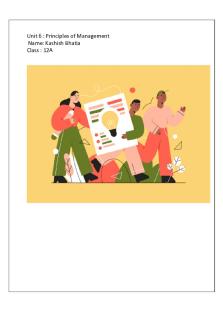
btec business Unit 6
- 6 Pages

BTEC Business Unit 21 assignment 2
- 19 Pages

BTEC Business Unit 5 Assignment 1
- 27 Pages

Btec Business Assignment 1 AB
- 12 Pages
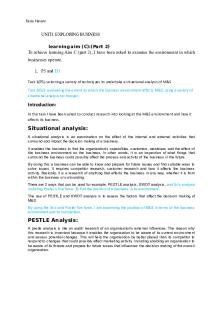
(Part 2) P5 & D2 - btec business
- 30 Pages
Popular Institutions
- Tinajero National High School - Annex
- Politeknik Caltex Riau
- Yokohama City University
- SGT University
- University of Al-Qadisiyah
- Divine Word College of Vigan
- Techniek College Rotterdam
- Universidade de Santiago
- Universiti Teknologi MARA Cawangan Johor Kampus Pasir Gudang
- Poltekkes Kemenkes Yogyakarta
- Baguio City National High School
- Colegio san marcos
- preparatoria uno
- Centro de Bachillerato Tecnológico Industrial y de Servicios No. 107
- Dalian Maritime University
- Quang Trung Secondary School
- Colegio Tecnológico en Informática
- Corporación Regional de Educación Superior
- Grupo CEDVA
- Dar Al Uloom University
- Centro de Estudios Preuniversitarios de la Universidad Nacional de Ingeniería
- 上智大学
- Aakash International School, Nuna Majara
- San Felipe Neri Catholic School
- Kang Chiao International School - New Taipei City
- Misamis Occidental National High School
- Institución Educativa Escuela Normal Juan Ladrilleros
- Kolehiyo ng Pantukan
- Batanes State College
- Instituto Continental
- Sekolah Menengah Kejuruan Kesehatan Kaltara (Tarakan)
- Colegio de La Inmaculada Concepcion - Cebu


